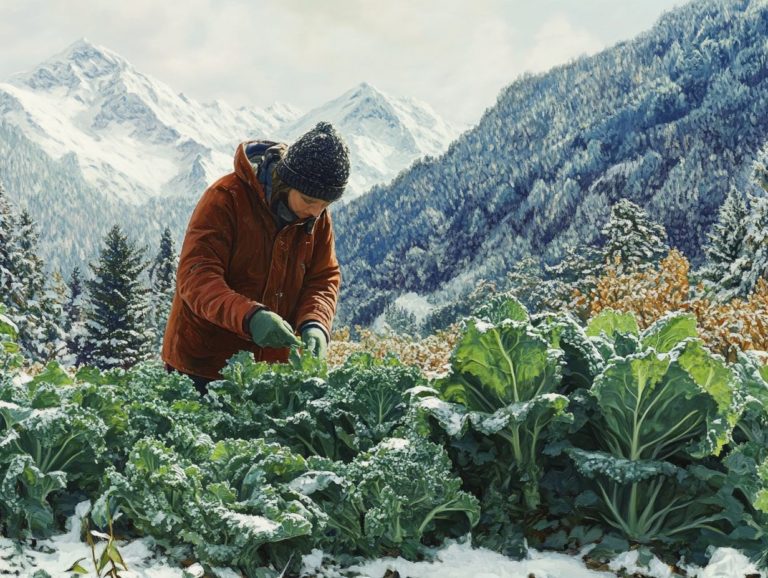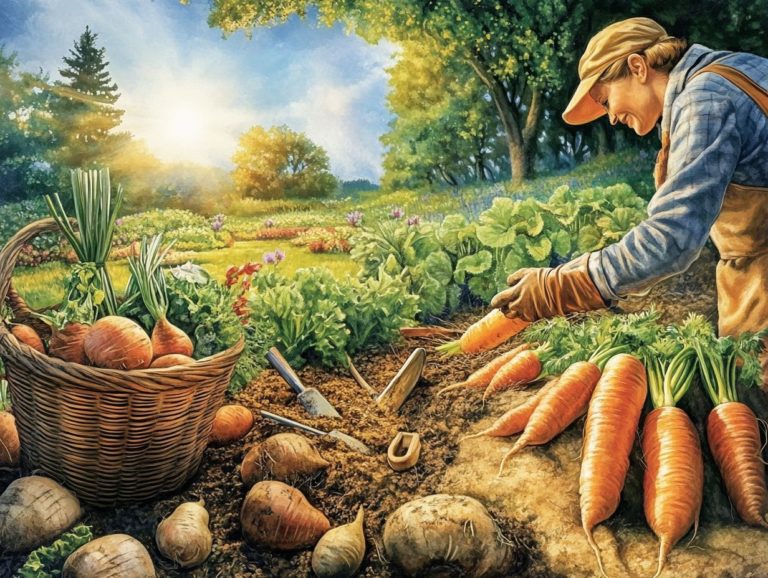Using Mulch to Protect Winter Crops
Mulching serves as a formidable ally for you, whether you re a gardener or a farmer, especially when it comes to safeguarding your winter crops.
This article covers the basics of mulch. It highlights different types and the significant benefits it offers in winter.
You’ll uncover best practices for application, discover tips to maximize its advantages, and learn about common pitfalls to steer clear of.
Explore alternative methods to ensure your winter crops flourish. Join us on this journey to discover how mulch can elevate your garden’s resilience!
Contents
- Key Takeaways:
- Unlock the Power of Mulch for Your Garden
- Types of Mulch for Winter Protection
- Applying Mulch to Winter Crops
- Maximizing the Benefits of Mulch
- Common Mistakes to Avoid when Using Mulch
- Protect Your Crops This Winter!
- Alternative Methods for Winter Crop Protection
- Frequently Asked Questions
- Can I use any type of mulch to protect my winter crops?
- When is the best time to apply mulch to my winter crops?
- How thick should the mulch layer be for winter crop protection?
- Do I need to remove the mulch in the spring?
- Can I use mulch to protect winter crops in all climates?
- What precautions should I take when using mulch for winter crops?
Key Takeaways:

- Mulch protects winter crops from extreme temperatures and moisture loss.
- Organic mulch, like straw or leaves, enhances soil health more than plastic options.
- Proper application and maintenance of mulch are essential to prevent damage to crops.
Unlock the Power of Mulch for Your Garden
Understanding mulch and its myriad benefits is essential for any gardener looking to safeguard their plants through the unforgiving winter months. Mulch serves a critical purpose in maintaining soil temperature, minimizing frost damage, and boosting the overall vitality of perennial beds and landscape plants.
By employing organic materials like bark, hay, and pine needles, you can craft effective winter mulch layers that not only insulate shallow-rooted and delicate plants but also enhance the aesthetic appeal and winter interest of your garden. Mastering proper mulching techniques can substantially elevate your garden s resilience in the face of cold weather.
What is Mulch?
Mulch serves as a protective layer of organic or inorganic materials spread across the soil surface, enhancing plant growth in the process.
This versatile material comes in various forms, with organic options like straw, bark, and pine needles each offering distinct benefits to soil health. Organic mulch enriches the soil as it decomposes, delivering essential nutrients and fostering beneficial microorganisms. In contrast, inorganic varieties, such as gravel or plastic, provide a durable solution for moisture retention and weed suppression, maintaining their integrity over time.
By covering the soil, mulch not only helps maintain a stable temperature but also nurtures plant roots, promoting robust growth through adequate moisture and nutrient availability. Your choice of mulch can profoundly influence the sustainability and productivity of your garden, especially when considering the specific needs of tender plants.
Advantages of Using Mulch for Winter Crops
Using mulch for winter crops presents a range of advantages that play a crucial role in safeguarding your plants from harsh weather conditions, including using row covers for winter protection.
By offering insulation against extreme temperatures, winter mulch helps maintain a more stable root environment, which is essential for crops like garlic and overwintering onions. It acts as a protective barrier, shielding vulnerable plants from frost damage and ensuring that seedlings can emerge robust and healthy come springtime.
This protective layer also enhances moisture retention, reducing the frequency of irrigation during dry winter spells, which is particularly beneficial for crops such as carrots and beets. Effective weed suppression reduces competition for nutrients and water, allowing your crops to thrive without the added stress of battling unwanted plants. This is crucial for ensuring the health of your perennial beds.
Types of Mulch for Winter Protection
Grasping the various types of mulch available for winter protection is crucial for you as a gardener aiming to enhance the health and resilience of your plants, especially when considering how different materials can impact soil temperature.
Organic vs. Inorganic Mulch
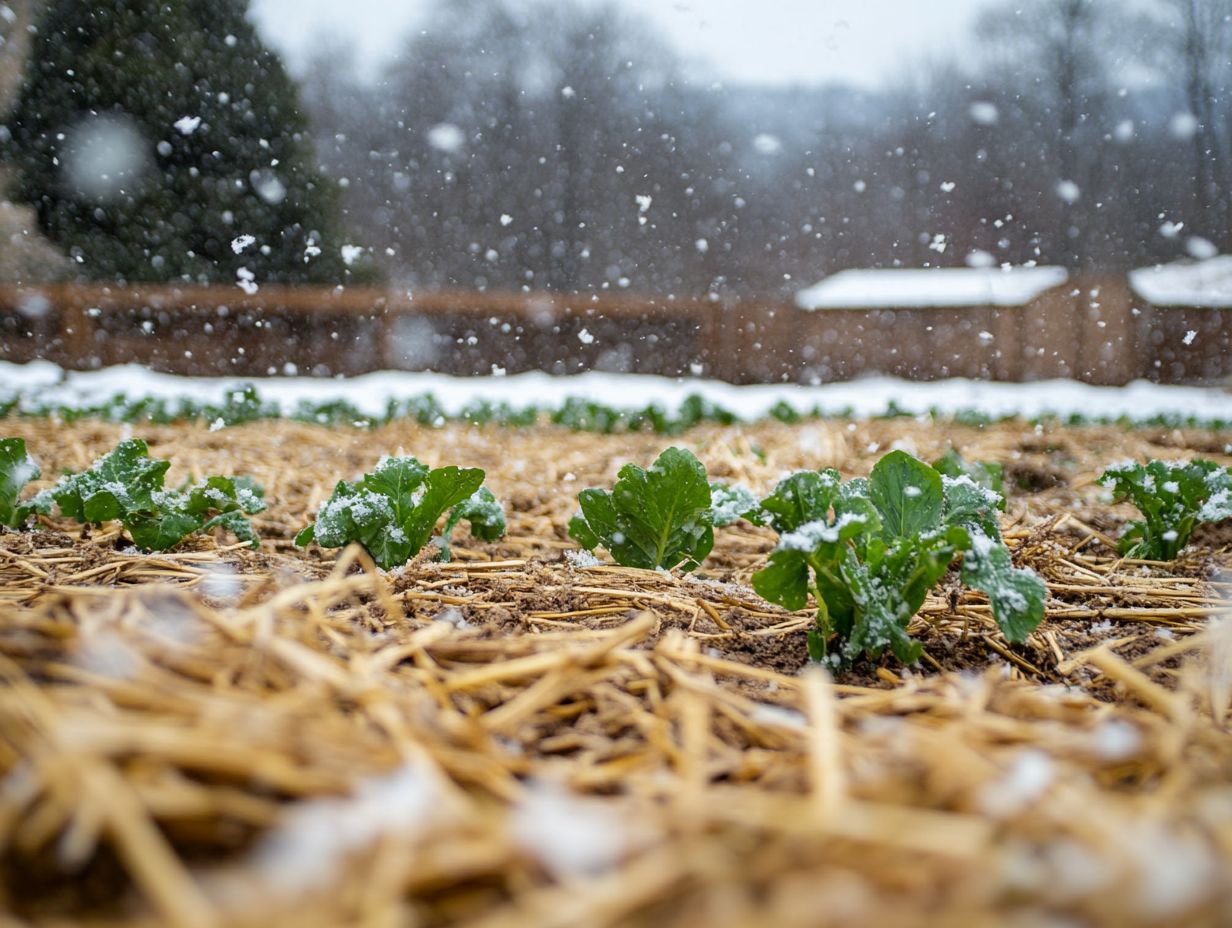
Organic and inorganic mulches offer unique benefits for winter protection. Understanding their differences is essential for effective gardening.
Organic mulches include straw, wood chips, and shredded leaves. They insulate plant roots and enrich soil with nutrients as they break down.
Inorganic options like rubber mats and gravel retain moisture and suppress weeds. However, they do not improve soil health.
Consider your gardening needs carefully. For instance, wood chips can help retain moisture for perennials, while gravel is great for durable pathways.
Applying Mulch to Winter Crops
Applying mulch is vital for the survival of your winter crops, as it protects them from harsh cold weather. To learn more about which mulching techniques work best in winter, consider exploring various methods.
Pay attention to detail during this process. Proper technique helps plants thrive in winter’s chill.
Best Practices for Mulching
Using best practices can enhance the protection and growth of your winter crops. Know when to remove mulch for optimal health.
Choose the right mulch for your needs, whether organic like straw or inorganic like landscape fabric. Apply it carefully; too thick a layer can suffocate plants.
Apply mulch just before winter to retain moisture and regulate soil temperature. Regularly refresh your mulch to maintain its benefits.
Maximizing the Benefits of Mulch
To reap the full benefits of mulch, adopt a strategic approach. Understand its role in protecting plants and promoting growth during winter.
Tips for Optimal Protection and Growth
For the best results, follow specific tips to enhance mulch effectiveness. Selecting the right materials like shredded bark or straw is crucial.
Apply mulch right before the ground freezes. This helps insulate roots and retains soil moisture.
Regularly check and refresh your mulch layer. This not only supports plant health but also adds visual appeal to your garden.
Common Mistakes to Avoid when Using Mulch
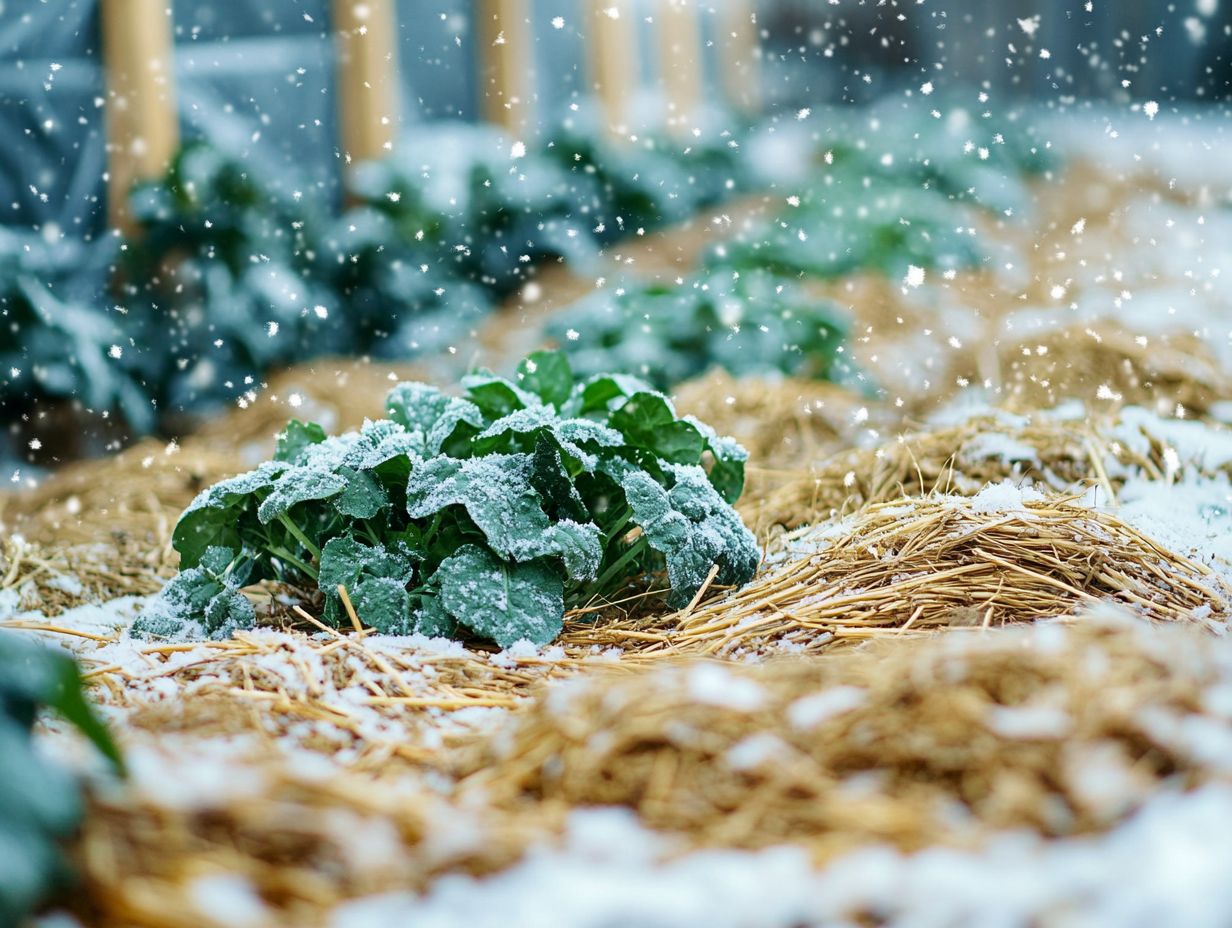
Avoid common mulch mistakes to protect your crops and enjoy a thriving garden. This ensures you maximize the benefits of your chosen mulch types.
Protect Your Crops This Winter!
Protecting your crops this winter takes effort and knowledge. Learn effective winter mulching techniques to shield them from frost and extreme cold. This is critical for ensuring the survival of shallow-rooted plants.
By crafting a solid plan, you can help your plants endure even the harshest conditions. Timing matters for mulching; remove it in early spring as soil temperatures rise, encouraging beneficial microorganisms to thrive. Monitoring soil temperature can guide your transition from winter protection to promoting growth.
Regularly check your plants’ health to catch any signs of stress or disease early. This allows for swift action to protect your crops. By emphasizing these proactive strategies, you’ll cultivate a resilient garden ready to flourish as the warmer months arrive, especially for your perennials.
Alternative Methods for Winter Crop Protection
Beyond traditional mulching, explore a variety of alternative methods to protect your winter crops. These options empower you to ensure your plants not only survive but thrive in the cold, enhancing their overall resilience.
Exploring Other Options for Winter Crop Care
Diverse strategies for winter crop care offer valuable insights into maintaining the health and vigor of your plants during colder months, particularly for protecting your perennial beds.
Consider techniques like cold frames, row covers, and interplanting to protect delicate plants from harsh frost and biting winds. These methods create a nurturing microclimate for your crops and enhance soil temperature and moisture retention both crucial for robust root development.
Pair these techniques with effective mulching practices that suppress weeds and regulate soil temperature for a bountiful harvest, even in winter. Sharing your knowledge about these practices can empower others in the gardening community to thrive, no matter the seasonal challenges they face.
Frequently Asked Questions
Can I use any type of mulch to protect my winter crops?
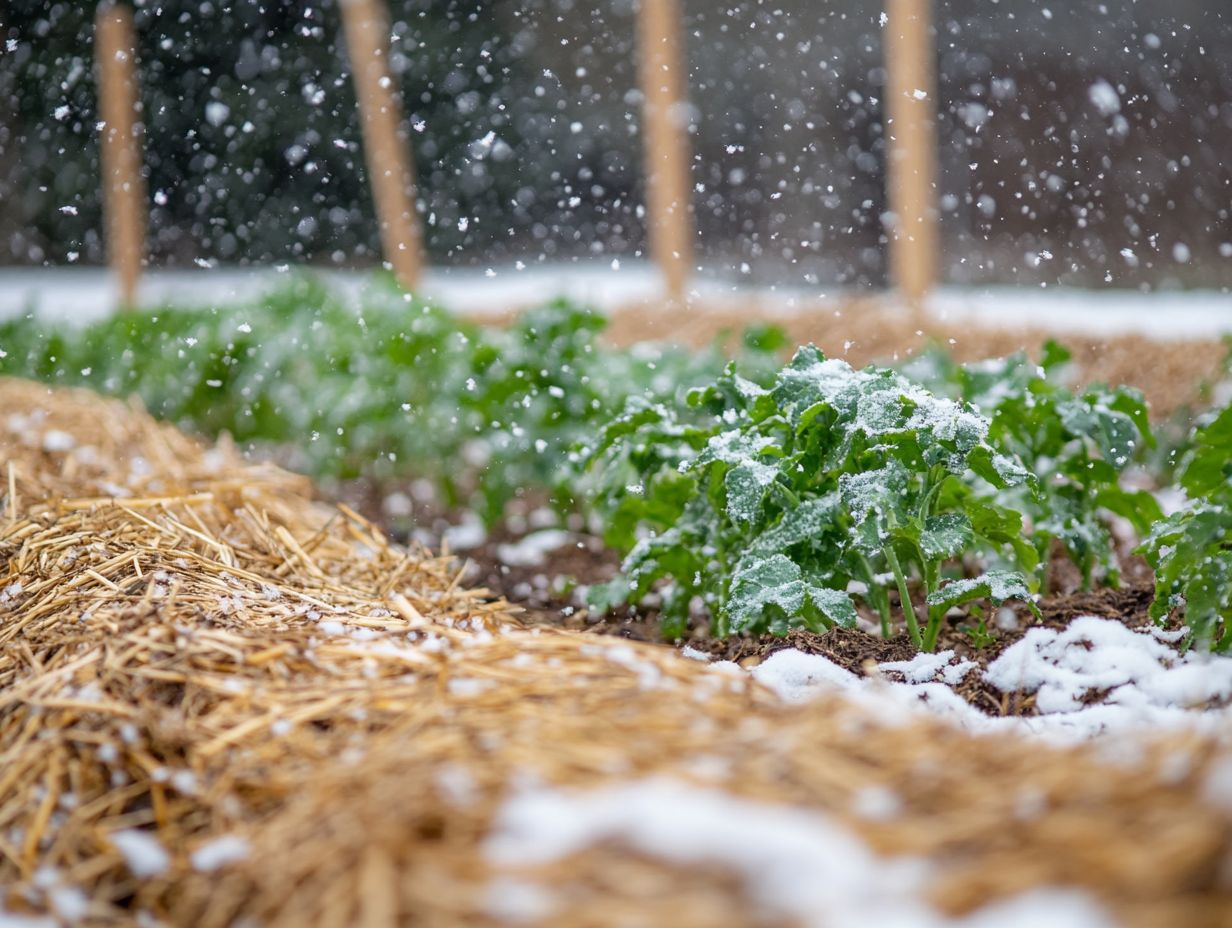
Yes, you can use straw, leaves, pine needles, or shredded bark as mulch. These materials protect against frost damage.
When is the best time to apply mulch to my winter crops?
The best time to apply mulch is after the first frost or when the ground begins to freeze. This provides insulation for the crops throughout winter.
How thick should the mulch layer be for winter crop protection?
The ideal thickness for mulch is 2-3 inches. This thickness provides insulation without suffocating the shallow-rooted plants and helps maintain soil temperature.
Do I need to remove the mulch in the spring?
Yes, it’s important to remove the mulch in spring to allow the soil to warm up and for the plants to receive sunlight. This also prevents potential mold or diseases from developing, mitigating risks from pathogens.
Can I use mulch to protect winter crops in all climates?
Yes, mulch can be used in all climates, especially in colder areas where the ground freezes. It provides insulation and prevents damage from frost heave. For gardeners in these regions, mulch layering is key.
What precautions should I take when using mulch for winter crops?
Yes, keep the mulch away from the stems of the plants. If it s too close, it can cause moisture buildup, which leads to rot. Use organic materials like straw or hay! They break down over time and enrich the soil, helping your perennials grow strong and healthy.



